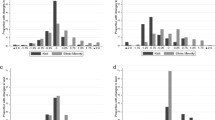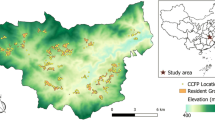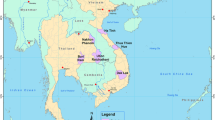Abstract
In the late 1990s, China’s Yangtze and Yellow River Basins suffered devastating natural disasters widely attributed to the degradation of soil and water resources. The Government of China responded with a number of major environmental programs, the most expensive and influential of which, the Grain for Green (GfG) Program, was implemented widely from 1999. Under the GfG Program—also known as the Sloping Land Conversion or Conversion of Cropland to Forest Program—the central government compensates farmers to convert cropland on steep slopes or otherwise ecologically sensitive areas to forest or grassland. Its long-term success depends on households’ ability to make sustainable changes to their household income streams and income diversification strategies. In this paper, we use a difference-in-difference estimation approach to examine the role of migration as a household-level response to the GfG Program, testing the extent to which individuals migrate following a reduction in land available for farming. Importantly, we exploit 15 years of data on migration decisions and establish that participating and non-participating households were on parallel migration paths before the program, thus refuting a key threat to causality in a difference-in-difference model. We find that participating families do, in fact, choose migration as an income diversification strategy more frequently than non-participants. The program effects varied over time but peaked post-Great Recession in 2011 when migration rates in GfG households exceeded those of non-GfG households by 5.9% points (p = 0.003) or about 26%. Our findings should encourage policymakers that families are making long-term adjustments to their livelihood strategies to avoid poverty in anticipation of the eventual withdrawal of government supports.

Similar content being viewed by others
Notes
Ultimately, ours is partial equilibrium analysis focusing on changes in migration and household income brought on by the GfG Program. A general equilibrium analysis considering downstream consequences of migrants’ decisions (for instance, working in a resource- or carbon-intensive industry in a polluted city) would provide a more comprehensive evaluation of sustainable resource management and be a source for future research with different data, but is not our objective here.
Households were dropped from our analysis for the following reasons. One respondent provided virtually no answers. Official reports from local government officials indicated that eight (1.7%) households that reported had never heard of what the GfG Program was, in fact, GfG participants. We dropped them given the questionable nature of their responses. An additional eight households were dropped because of missing values for income from remittances.
A t-test of government subsidy values revealed no significant difference between GfG and non-GfG families. Further, regressing a number of additional variables (household size, other income sources, asset levels) on government subsidies yielded neither statistically significant coefficients nor a significant overall F-test, and the R2 was just 0.0073. (Results not reported.) Given the lack of predictors for government subsidies, we imputed missing values using the sample mean.
We chose 50 as the maximum in our age range after running our full regression in Table 2 on all ages 16–65 and calculating the average marginal effects of the GfG Program at 5-year intervals. The effects switched from moderately significant (p = 0.075) at 50 to insignificant (p = 0.132) at 55.
Additionally, we used the same covariates to estimate the effect of the GfG Program on a household asset index we constructed from respondents’ qualitative but ordinal descriptions of eight different household asset categories, such as the family’s home, vehicles, water/sanitation facilities, and livestock. The effect was small and only marginally significant.
References
Agrawal A, Wollenberg E, Persha L (2014) Governing agriculture-forest landscapes to achieve climate change mitigation. Glob Environ Change 28:270–280
Alix-Garcia JM, Shapiro EN, Sims KRE (2010) The Environmental Effectiveness of Payments for Ecosystem Services in Mexico: Preliminary Lessons for REDD. Draft Paper. Department of Agriculture and Applied Economic, University of Wisconsin, Madison.
Carr D (2009) Population and deforestation: why rural migration matters. Prog Hum Geogr 33(3):355–378
Chen X, Frank KA, Dietz T, Liu J (2012) Weak ties, labor migration, and environmental impacts: toward a sociology of sustainability. Organ Environ 25(1):3–24
China State Forestry Administration (2014) National report of the ecological monitoring of the conversion of cropland to forest program. China Forestry Press, Bejing
Daniels AE, Bagstad K, Esposito V, Moulaert A, Rodriguez CM (2010) Understanding the impacts of Costa Rica’s PES: are we asking the right questions? Ecol Econ 69(11):2116–2126
Delang CO, Yuan Z (2015) China’s grain for green program: a review of the largest ecological restoration and rural development program in the world. Springer International Publishing, Switzerland
Démurger S, Wan H (2012) Payments for ecological restoration and internal migration in China: the sloping land conversion program in Ningxia. IZA J Migr 1(10):1–22
Greenwood MJ (2016) Perspectives on migration theory—economics. In: White MJ (ed) International Handbook of Migration and Population Distribution. Springer, New York, NY, p 31–40
Groom B, Grosjean P, Kontoleon A, Swanson T, Zhang S (2010) Relaxing rural constraints: a ‘win-win’policy for poverty and environment in China? Oxf Econ Pap 62(1):132–156
Grosjean P, Kontoleon A (2009) How sustainable are sustainable development programs? The case of the sloping land conversion program in China. World Dev 37(1):268–285
Hecht S (2010) The new rurality: globalization, peasants and the paradoxes of landscapes. Land Use Policy 27:161–169
Kelly P, Huo X (2013) Land retirement and nonfarm labor market participation: an analysis of china’s Sloping Land Conversion Program. World Dev 48:156–169
Li J, Feldman MW, Li S, Daily GC (2011) Rural household income and inequality under the Sloping Land Conversion Program in western China. Proc Natl Acad Sci 108(19):7721–7726
Liang Y, Li S, Feldman MW, Daily GC (2012) Does household composition matter? The impact of the Grain for Green Program on rural livelihoods in China. Ecol Econ 75:152–160
Liang Z, Li Z, Ma Z (2014) Changing patterns of the floating population in China, 2000–2010. Popul Dev Rev 40(4):695–716
Liu Z, Lan J (2015) The Sloping Land Conversion Program in China: effect on the livelihood diversification of rural households. World Dev 70:147–161
Nielsen ØJ,Rayamajhi S,Uberhuaga P,Meilby H,Smith‐Hall C,(2013) Quantifying rural livelihood strategies in developing countries using an activity choice approach Agric Econ 44(1):57–71
Pattanayak SK, Wunder S, Ferraro P (2010) Show me the money: do payments supply environmental services in developing countries? Rev Environ Econ Policy 4(2):254–274
Pfaff A, Amacher GS, Sills EO (2013) Realistic REDD: improving the forest impacts of domestic policies in different settings. Rev Environ Econ Policy 7(1):114–135
Qin H (2010) Rural-to-urban labor migration, household livelihoods, and the rural environment in Chongqing municipality, southwest China. Hum Ecol 38(5):675–690
Qin H, Liao T (2016) Labor out-migration and agricultural change in rural China: a systematic review and meta-analysis. J Rural Stud 47:533–541
Reardon T, Berdegué J, Barrett CB, Stamoulis K (2007) Household income diversification into rural non-farm activities. In: Haggplade S, Hazell P, Reardon T (eds) Transforming the rural nonfarm economy. Johns Hopkins University Press, Baltimore, p 115–140
Song C, Zhang Y, Mei Y, Liu H, Zhang Z, Zhang Q, Zha T, Zhang K, Huang C, Xu X, Jagger P (2014) Sustainability of forests created by China’s Sloping Land Conversion Program: a comparison among three sites in Anhui, Hubei and Shanxi. For Policy Econ 38:161–167
Song C, Zhang Y (2009) Forest cover in China from 1949 to 2006. In: Nagrenda H, Southworth J (eds) Reforesting landscapes. Springer, Netherlands, p 341–356
Sun J, Zhao C, Wang L (2002) The long march of green: the chronicle of returning agricultural land to forests in China. China Modern Economics Press, Beijing
Tang XL (2007) China’s ecological restoration programs and policy. Paper presented at the International Symposium on Evaluating China’s Ecological Restoration Programs, Beijing.
Uchida E, Xu J, Rozelle S (2005) Grain for green: cost-effectiveness and sustainability of china’s conservation set-aside program. Land Econ 81(2):247–264
Uchida E, Xu J, Xu Z, Rozelle S (2007) Are the poor benefiting from China’s land conservation program? Environ Dev Econ 12(4):593–620
Uchida E, Rozelle S, Xu J (2009) Conservation payments, liquidity constraints and off-farm labor: impact of the Grain-for-Green program on rural households in China. Am J Agric Econ 91(1):70–86
Xu Z, Bennett MT, Tao R, Xu J (2004) China’s Sloping Land Conversion Programme four years on: current situation and pending issues. Int For Rev 6(3-4):317–326
Xu J, Yin R, Li Z, Liu C (2006) China’s ecological rehabilitation: unprecedented efforts, dramatic impacts, and requisite policies. Ecol Econ 57(4):595–607
Wang F, Li R, Wen Z, Zhou L (2003) Problems and recommendations for the conversion of cropland to forest (grassland) program: survey and analysis of test sites for conversion of cropland to forest (grassland) program in Ansai County, Shaanxi Province. J Northwest Sci-Tech Univ Agric For 3(1):60–65
White MJ, Johnson C (2016) Perspectives on migration theory—sociology. In: White MJ (Ed.) International handbook of migration and population distribution. Springer, New York, NY, pp 69–90
Yao S, Guo Y, Huo X (2010) An empirical analysis of the effects of China’s land conversion program on farmers’ income growth and labor transfer. Environ Manag 45(3):502–512
Yin R, Yin G (2009) China’s ecological restoration programs: Initiation, implementation, and challenges. In: Yin R (ed) An integrated assessment of China’s ecological restoration programs. Springer, New York, NY, p 1–19
Yin R, Yin G (2010) China’s primary programs of terrestrial ecosystem restoration: initiation, implementation, and challenges. Environ Manag 45(3):429–441
Zhang A, Zinda JA, Li W (2017) Forest transitions in Chinese villages: explaining community-level variation under the returning forest to farmland program. Land Use Policy 64:245–257
Zhao J, Barry PJ (2014) Income diversification of rural households in China. Canadian J Agric Econ 62:307–324
Acknowledgements
We thank Mr. Hongsheng Zhou at China’s State Forestry Administration for his support to this research; Dr. Qingfeng Huang at Anhui Agricultural University and the Forestry Station at Tiantangzhai Township; and the Tianma National Nature Reserve for their support of the household survey.
Funding
This research is supported by the U.S. National Science Foundation (Grant No. DEB-1313756). Additionally, we are grateful to the Carolina Population Center (P2C HD050924) at The University of North Carolina at Chapel Hill for general support.
Author information
Authors and Affiliations
Corresponding author
Ethics declarations
Conflict of interest
The authors declare that they have no conflict of interest.
Appendix
Rights and permissions
About this article
Cite this article
Treacy, P., Jagger, P., Song, C. et al. Impacts of China’s Grain for Green Program on Migration and Household Income. Environmental Management 62, 489–499 (2018). https://doi.org/10.1007/s00267-018-1047-0
Received:
Accepted:
Published:
Issue Date:
DOI: https://doi.org/10.1007/s00267-018-1047-0




